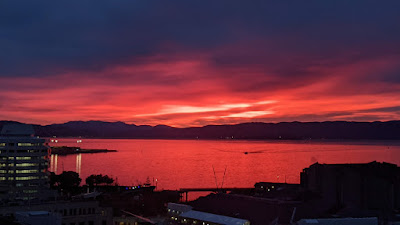The Amusements section of Wellington's Dominion morning newspaper for Monday 31 August 1925 carries the usual detailed advertisements for cinema and theatre offerings, illustrating the busy entertainment scene in the capital a hundred years ago. Four cinemas advertised their wares, plus one theatre with a jam-packed vaudeville programme.
The DeLuxe Theatre ('The Finest Theatre under the Southern Cross')
The Thundering Herd was directed by
William K. Howard and featured Jack Holt, Lois Wilson, Noah Beery Sr. and Raymond Hatton. The Paramount film was a lightning-fast page-to-screen journey for a Zane Grey western novel released in the same year. It features the entire bison population of Yellowstone in a climactic stampede scene.
Howard was a busy director in the 1920s and '30s, and his 1933 Spencer Tracy film The Power & the Glory is now recognised as an early influence on Citizen Kane.
Jack Holt was at this point a 37-year-old actor best known for his roles in Westerns. His son Tim Holt would also become a Hollywood Western star for RKO in the 1940s. Father and son would both appear in John Huston's The Treasure of the Sierra Madre, with Holt Sr. in a minor, uncredited role.
One of the WAMPAS Baby Stars of 1922, Lois Wilson was 31 in 1925. The following year she would appear as Daisy Buchanan in the first film adaptation of The Great Gatsby.
The Thundering Herd, like many silent films of the era, has not survived. The De Luxe was built the previous year and since 1945 it has been known as the Embassy, Wellington's premier cinema.
King's Theatre ('Wellington's Popular Picture House')
Locked Doors was a romantic drama directed by
William C. de Mille, elder brother of the more famous Cecil. In melodramatic circumstances a married woman Mary (
Betty Compson) becomes infatuated with another man, John (Theodore von Eltz), who is then invited to move in by the married woman's husband, Norman (Theodore Roberts) to forget about another failed love affair. High drama ensues when a house fire traps Mary and John together in her bedroom, and they are discovered by Norman. Like
The Thundering Herd,
Locked Doors is a lost silent film.
Utah-born Betty Compson was 28 in 1925 and had been a film actor since 1915. Her success in the early 1920s enabled her to start her own film production company. In 1928, the year of the second Oscar ceremony, she was nominated for an Academy Award for Best Actress for her role in The Barker, but lost out to Mary Pickford in Coquette.
The King's was New Zealand's first purpose-built movie theatre, and opened on Dixon St in 1910. It was demolished in 1986.
Queen's Theatre ('The Cosiest House in Town')
Still enjoyed today, the 1924 silent comedy
Sherlock Jr. is directed by and stars silent era comedy legend
Buster Keaton. A 45-minute classic featuring a cinema projectionist (Keaton) who, unlucky in love, falls into a dream that he is the World's Greatest Detective. In this dream he solves a great crime to clear his name and win the heart of The Girl (Kathryn McGuire) from a dastardly villain. The Girl's father is played by Joe Keaton, Buster's father.
One of Keaton's dozen or so silent comedy classics of the mid-1920s, Sherlock Jr. was constructed around Keaton's desire for a regular Joe character to walk into a movie-screen and become the hero. In 2005 Time magazine named it as one of the 100 greatest films of all time. It entered the public domain on 1 January 2020.
The Queen's opened in Cuba St in 1916 and operated as a cinema until 1955, when it was converted into a billiard hall. It is now occupied by Loretta Cafe in the building next door to Slow Boat Records.
Paramount Theatre
The Great White Way was a boxing flick directed by
E. Mason Hopper and released in January 1924. Made in cooperation with the New York City Fire Department, the ten-reeler features
Anita Stewart as Follies dancer Mabel, who falls in love with prize-fighter Joe (
Oscar Shaw). In it, Joe has to win a big bout to secure the funds to secure Mabel's show from an unscrupulous promoter. The film was produced by William Randolph Hearst for Goldwyn Pictures. It is also a lost picture.
Hopper was a prolific silent film director from 1917 until the end of the 1920s. He also appeared in an uncredited role as a doctor in the 1950 classic Sunset Boulevard. Stewart's real first name was Anna but Vitagraph accidentally publicised her as Anita, which she later adopted. For four years until 1922 she had operated her own production company, and shortly after The Great White Way she left the major studios and took roles in 'Poverty Row' studios to stay working; her final film was in 1928. She also wrote a murder mystery novel, The Devil's Toy, in 1935. Shaw was mainly a stage actor, and is now best known for appearing in the Marx Brothers' first film, The Cocoanuts (1929).
The Paramount operated as a cinema from 1917 to 2017. The last Wellington Film Society screening there was Wim Wenders' 1974 road movie, Wrong Move.
His Majesty's Theatre
Offering a 'brand new bill that for entertainment value has never been approached in the history of N.Z. Vaudeville', His Majesty's presented Australian "Prince of Comedians" Jim Gerald and his titular Revue Company in their production 'Not Likely', which was billed as "A 100 per cent laughing show with Jimmy as a bonus Chemist's Assistant". Also on the bill was the New York comedy novelty act Three White Kuhns, and comedians George Edwards and Molly Hughes. His Majesty's opened in 1912, and since 1930 has been known as the St James.
See also:
Blog:
100th anniversary of the Embassy Theatre, 31 October 2024




















